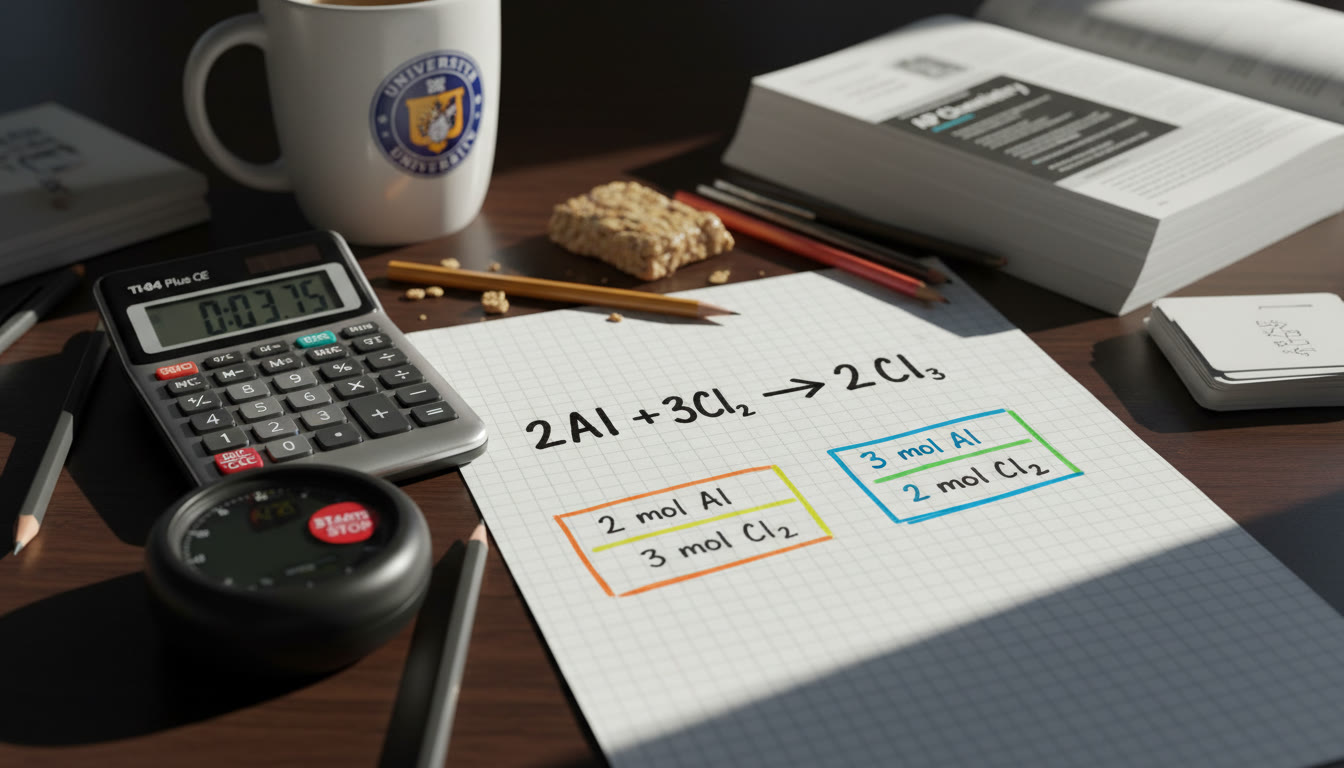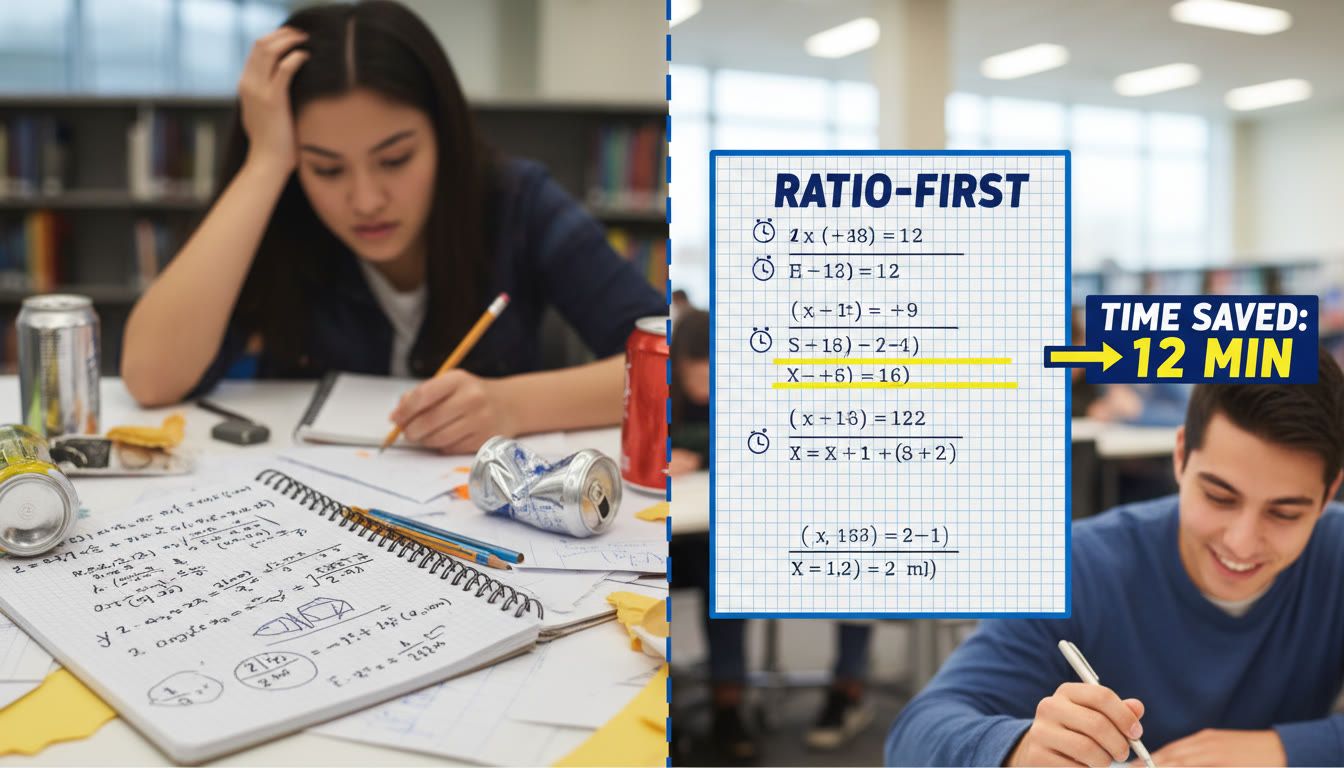Why Stoichiometry Feels Like a Race (And How to Win)
If you’ve ever stared at a stoichiometry problem in the middle of an AP Chemistry exam and felt your pulse quicken, you’re not alone. Stoichiometry is where chemical logic meets arithmetic discipline—and when the clock’s ticking, even small inefficiencies in thinking or setup can cost you big.
This post is written for students who want to keep accuracy high and time spent low. We’ll focus on ratio-based shortcuts, mental set-ups, and clean workflows that consistently save minutes on exam day. You’ll get patterns you can use in multiple problems, quick checks to avoid careless mistakes, and practice-ready examples. Along the way, I’ll mention how targeted help—like Sparkl’s personalized tutoring—can give you tailored practice and one-on-one feedback to eliminate stuck points faster.
The Stoichiometry Mindset: Think Ratios Before Numbers
Stoichiometry is fundamentally about ratios: coefficients in balanced equations tell you how many moles of one species relate to another. When you internalize that ratio-first mindset, arithmetic becomes translation work rather than invention.
Core Principles to Memorize
- Always start from a balanced equation: coefficients = ratios.
- Convert everything to moles for direct ratio application.
- Use mole ratios as the bridge between substances.
- Only convert out of moles at the end (to grams, liters at STP, molecules, etc.).
- Keep units visible through each step—this is your built-in error check.
Speed Tricks: Ratio Shortcuts That Save Time
Here are practical shortcuts that shorten your written work and your thinking time. They’re safe when used carefully and paired with quick sanity checks.
1) Coefficient Ratios—Use Them Directly
Example shortcut: From 2 H2 + O2 → 2 H2O, the H2 : H2O ratio is 2:2 = 1:1. If you’re given 3.50 mol H2, you immediately know it yields 3.50 mol H2O—no intermediate mass step required.
2) Fraction Reduction Early
When coefficients are large, reduce them before plugging into arithmetic. For 4 Al + 3 O2 → 2 Al2O3, the Al : Al2O3 ratio 4:2 reduces to 2:1. If you have 0.75 mol Al, the product moles are 0.375 mol Al2O3—fast mental math.
3) Work in Terms of ‘Per 1’ When Possible
Normalize the balanced equation to a per-1 basis for quick proportional thinking. For example, if the balanced equation gives 3 A → 2 B, think “per 1 A makes 2/3 B.” Then multiply by the given moles of A. This is especially helpful with non-integer mole amounts.
4) Use Mass-to-Mass Shortcuts Sparingly
Often problems ask for grams of product from grams of reactant. The standard route is grams → moles → ratio → moles → grams. To speed this up mentally, keep molar masses (MM) you commonly use memorized or estimated, and combine ratios algebraically so you do only one conversion. For example:
grams A × (1 mole A / MM A) × (coefficient B / coefficient A) × (MM B / 1 mole B) = grams B
When you write it all in one line you cut down on rewriting and isolated arithmetic errors.
Common Exam Scenarios and Concise Workflows
Below are frequent stoichiometry set-ups with concise templates to follow under time pressure.
Scenario A: Mass of Product from Mass of Reactant
- Step 1: Confirm equation balanced.
- Step 2: Convert given mass → moles (use MM).
- Step 3: Apply mole ratio (from coefficients).
- Step 4: Convert moles product → grams (use MM).
- Quick check: Is product mass less than reactant mass if limiting reagent is same element? Think conceptually.
Scenario B: Limiting Reagent (Fast)
The fastest way: convert the same given amount of each reactant to moles of the product (choose the product that’s easiest or specified). The reagent that produces fewer moles of the product is limiting. This avoids the slower method of finding theoretical yields independently and comparing.
Scenario C: Percent Yield and Theoretical Yield
- Find theoretical yield using standard steps.
- Percent yield = (actual / theoretical) × 100% — keep this formula memorized.
- For quick checks: yields over 100% usually indicate measurement error or impure samples—use this as a red flag.

Worked Example: Practice with a Timer
Let’s walk through a timed example you might see on the AP exam. Aim to solve in under 3 minutes once you’re practiced.
Problem
Given the reaction: 2 Al + 3 Cl2 → 2 AlCl3, how many grams of AlCl3 can be produced from 4.50 g Al and 7.20 g Cl2? (MM Al = 26.98 g/mol; MM Cl2 = 70.90 g/mol; MM AlCl3 = 133.34 g/mol)
Fast Setup
- Convert given masses to moles: 4.50 g Al × (1 mol / 26.98 g) ≈ 0.1669 mol Al.
- 7.20 g Cl2 × (1 mol / 70.90 g) ≈ 0.1016 mol Cl2.
- Use ratios to find moles AlCl3 producible from each reactant:
| Reactant | Moles Given | Mole Ratio to AlCl3 | Moles AlCl3 Possible |
|---|---|---|---|
| Al | 0.1669 mol | 2 Al : 2 AlCl3 → 1:1 | 0.1669 mol |
| Cl2 | 0.1016 mol | 3 Cl2 : 2 AlCl3 → (2/3) | 0.1016 × (2/3) ≈ 0.0677 mol |
Cl2 gives the smaller product amount, so Cl2 is limiting. Convert moles AlCl3 from Cl2 to grams:
0.0677 mol × 133.34 g/mol ≈ 9.03 g AlCl3.
Quick sanity check: The product mass (9.03 g) is reasonable given the inputs (total reactant mass 11.70 g), and percent yield would be less than or near 100% if actual yield were provided.
Table of Handy Conversions and Reminders
| Concept | Quick Reminder |
|---|---|
| Moles ↔ Particles | 1 mol = 6.02 × 10^23 particles (Avogadro’s number). |
| Moles ↔ Volume (gases at STP) | 1 mol gas ≈ 22.4 L at STP (use problem’s conditions; AP may specify different conditions). |
| Limiting Reagent | Compare moles of product producible from each reactant; smallest wins. |
| Percent Yield | (Actual / Theoretical) × 100% — always check units first. |
| Stoichiometric Excess | Optional: find leftover by converting limiting reagent consumption backward. |
Time-Saving Calculation Habits Under Pressure
Developing practical habits saves time and reduces careless mistakes. These are small behaviors that compound into big time wins.
Habit 1: Keep Units Visible
Write units at each step. If you lose track of units, you lose track of meaning. Units serve as both guide and guardrail, especially on complex multi-step conversions.
Habit 2: Do Fraction Cancelling on Paper, Not in Head
Cross out factors (like a 2 on top and bottom) to keep arithmetic small. This reduces reliance on mental multiplication under stress and is faster overall.
Habit 3: Use ‘Per 1’ to Avoid Rewriting Large Expressions
When you see repeated ratios across several problems, normalize once and reuse that mental fraction. It reduces repeated formula writing and accelerates chaining conversions.
Habit 4: Learn to Estimate Reasonableness Fast
Quick estimation helps catch errors. If the calculation says 5000 g of product from 5 g of reactant, stop and re-evaluate. On exams, quick sanity checks let you salvage points if arithmetic fails.
Practice Routines That Build Speed
Speed comes from deliberate, focused practice—short, concentrated drills that target weak spots. Here’s a weekly plan you can adapt in the weeks before the AP exam.
Two-Week Drill Plan (Example)
- Days 1–3: 20 timed problems per day focused on mass-to-mass and limiting reagent (2–4 minutes each).
- Days 4–6: 20 problems per day including gas stoichiometry, empirical formulas, and percent yield.
- Days 7–9: Mixed sets including multi-step problems and conversions involving solutions (Molarity).
- Days 10–12: Simulated exam sections under timed conditions; review incorrect approaches with emphasis on ratio setup.
- Day 13–14: Light review, formula sheet consolidation, mental rehearsal of steps and time-saving habits.
Pair this with one-on-one review sessions where you explain mistakes aloud to a tutor or peer. Explaining your process will highlight hidden assumptions and weak algebra steps. If you want a structured, efficient plan tailored to your exact weaknesses, Sparkl’s personalized tutoring offers tailored study plans and expert tutors who can pinpoint recurring errors and give AI-driven insights to accelerate improvement.
Quick Reference: Problem Templates You Can Memorize
- Mass → Mass: grams A → moles A → mole ratio → moles B → grams B
- Volume (gas) → Mass: L gas → moles gas (use 22.4 L or given conditions) → mole ratio → grams
- Moles → Particles: moles × 6.02 × 10^23
- Limiting reagent shortcut: convert each given to moles of the chosen product; smaller → limiting.
Common Mistakes and How to Avoid Them
- Forgetting to balance: Always rewrite the balanced equation—never trust memory alone.
- Using approximate molar masses carelessly: Round reasonably in early steps, but use full calculator values for final answers when precision matters.
- Unit mismatch: Label everything. Units will show you where you went wrong faster than re-doing arithmetic.
- Rushing the limiting reagent step: Do the ‘convert to product’ method—it’s faster and less error-prone.

How to Use Practice Tests to Improve Both Speed and Accuracy
Practice tests aren’t just about exposing content gaps; they’re the laboratory for your timing strategy. Treat each full-length practice section like the real thing: use the same scratch paper layout, simulate distractions, and replicate your exam day routine. After each test, do a focused analysis:
- Identify which stoichiometry problems took the longest and why.
- Isolate whether time was lost in concept, setup, or arithmetic.
- Create micro-drills that target the slowest step—10 problems focusing only on that piece.
For many students, a few targeted sessions with a tutor to refine the setup and eliminate a recurring algebraic error produces outsized gains. That targeted feedback—especially when it’s personalized and backed by data on your weak areas—can be the difference between a shaky and a confident approach to stoichiometry.
Final Checklist for Exam Day
- Bring a reliable calculator and know its functions (scientific notation, parentheses, unit conversion ease).
- Write balanced equations first; box mole ratios.
- Do fraction reduction before multiplying large numbers.
- Cross-check units at each conversion step.
- Use estimation to catch outliers quickly.
- If stuck, move on and return—time management beats stubborn perfectionism.
Wrapping Up: Mastery Is Ratios + Routine
Stoichiometry under time pressure becomes manageable when you stop treating each problem as a unique beast and start seeing it as a ratio-translation task. The moment you reliably convert words into a mole-ratio map, the arithmetic is just mechanics.
Build speed through deliberate practice, use the templates and habits above, and incorporate quick sanity checks. If you want to accelerate progress, consider focused one-on-one guidance—personalized tutoring can help you refine the exact small habits that cost time on exam day. Tutors who use targeted practice and AI-driven insights can shorten the path from confusion to fluency.
Keep practicing, time yourself, and reward improvements—even small ones are huge when you add them up. On test day, let the ratios guide you; your calm, practiced procedure will take care of the rest.















No Comments
Leave a comment Cancel